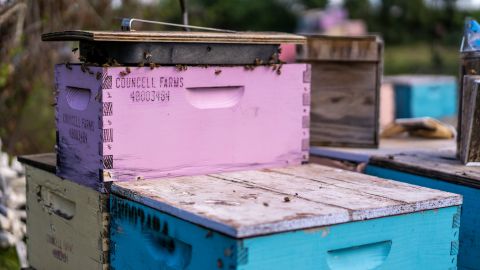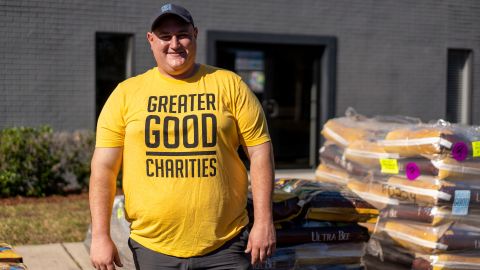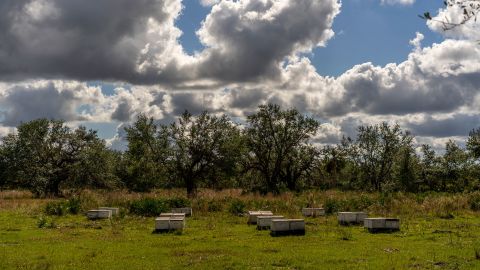Arcadia, Florida
CNN
—
Their busy, buzzing business partners pollinate everything from almonds in California to blueberries in Maine, so few people understand the state of American agriculture quite like Florida beekeepers.
But colliding climate crises have left few as sad and worried.
The storms and droughts of ’22 had already taken their toll on crop yields and a drying Mississippi was clogging harvest shipments when Hurricane Ian blasted into the nation’s apiary epicenter in central Florida. The storm drowned or crushed hundreds of thousands of hives, killing bees by the hundreds of millions – and those that survived are starving.
“Our entire ecosystem is flipped upside down and twisted up like a blender,” Keith Councell told CNN as he picked through piles of shattered and sodden hives on his farm near Arcadia, a little north and inland from Fort Myers.
“This was really bad because we were in the prime Brazilian pepper bloom,” he explained. “That’s our main source of nectar in the fall.”
Much of the American beekeeping industry winters in the Sunshine State to catch the dependable bloom of the Brazilian pepper tree before shipping fresh bees to California for the February almond crop and then onwards to some 130 fruit and vegetable seasons across the country.
But just as hives were filling with honey and young bees in late September, the Category 4 storm raked ashore, not only tossing and flooding tens of thousands of bee boxes but ripping the flowers and leaves off of hundreds of square miles of forage. “Some of those trees have been sandblasted,” Councell said. And in another cruel twist, some trees are putting out “stress blooms” as they die, which attract the hungry bees but carry no nutrition.
Emergency rations started to be trucked in when starving bees began robbing from other hives.
Councell tapped a plastic jug the size of a garden shed containing sugar water, nearby another full of corn syrup. The hope is that putting out jars of these sweet stuffs will be enough to keep bees alive for now.
“Ideally, they would be collecting different pollens from different plants, for all their amino acids and nutrition,” Councell said. “You can’t give bees one candy bar and expect them to survive on it. They need that full meal but right now, our environment…” He pointed at the shattered pepper trees and orange groves. “There’s nothing there.”

The next day, a dozen beekeepers milled around Mann Lake Bee and Ag Supply, trading stories of loss and filling out forms for federal aid, while Casey Paholski of Greater Good Charity stood by pallets of bee food, free for the grieving to take.
“This is part of our hurricane relief efforts,” he said, describing an effort to give away 500,000 pounds of pollen substitute. “We have donated meals to food pantries for humans and animal supplies to animal shelters and now we’re donating to bees. We can’t forget what helps get all the other food to the table.”
Before the storm, there were an estimated 650,000 managed hives around the state, each holding tens of thousands of bees and their brood. Experts say the full extent of the damage can’t be known for months. “These beekeepers lost equipment, they lost their bees,” said Amy Vu, a honeybee specialist with the University of Florida. “There is so much that they have lost which eventually will have an impact on the food production that we have nationwide. Once it comes time for beekeepers to fill those pollination contracts, they’ll have a better sense of how many colonies they have left.”

One out of every three bites of food comes courtesy of pollinators like honeybees, a USDA statistic that Andrew Wagner is fond of reciting on a tour of the Mann Lake warehouse. As branch manager, he supplies beekeepers of all sizes at a time when the natural world has been altered so dramatically that bees can no longer survive without human protection.
“Urbanization, drought, the lack of natural forage, cars, pesticides,” Wagner ticked off the threats. “If every beekeeper in the country just released all their bees into the wild, we estimate it’d be about 2 to 3 years before bees would just collapse. And that’s why we need the entire public to get educated and involved in bees. Just a few backyard hives make a big impact.”
But while homesteaders and backyard amateurs can add vital pockets of pollinators to even the most urban landscapes, the professionals in Florida worry about the next climate catastrophe on the calendar – the megadrought out west.
“If you don’t have California almonds, the commercial bee industry is probably going to collapse,” Jeremy Ham told CNN. His Old Florida Bee Company lost over 2,700 hives and he is feeding his survivors by the gallon, nonstop. “You have to make that tough decision: Is it worth the money to try to save it, or do you just have to walk away and take your medicine? There’re only so many locations to make honey. It’s not a pretty picture. I’m not a gloom and doom guy, I think it’s just the reality.”
